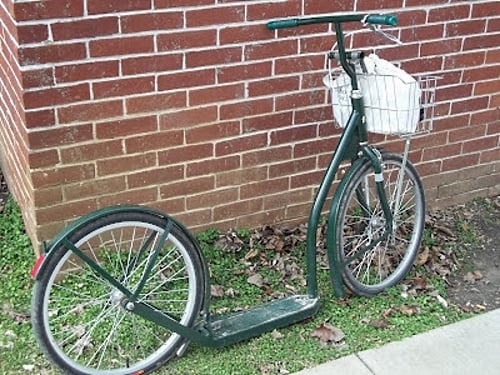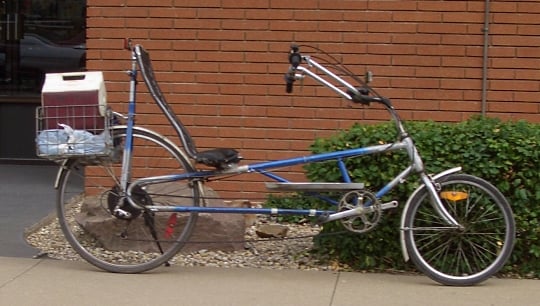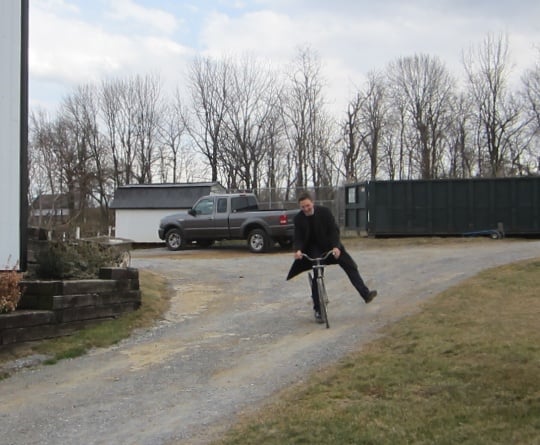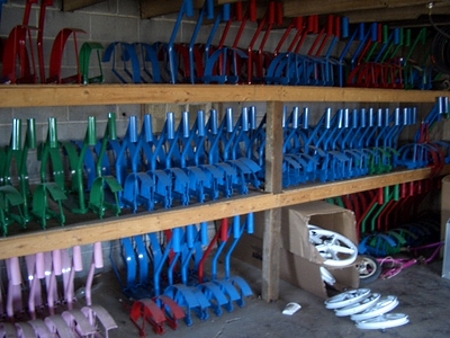Why Do Some Amish Ride Scooters (But Not Bicycles)?
Why scooters, but not bikes?
It’s a common question. I’ve never really come across a definitive answer, though have hit upon a theory or two after looking into it. Why do some Amish communities permit bicycles, but in others, only scooters are used? But I have good news. In an article at Lancaster Online, Steve Nolt provides an answer. It includes a couple of elements I did not expect.

Which Amish communities use scooters?
First, some brief background. Amish in communities such as Lancaster County, Geauga County, Ohio, and Allen County, Indiana use simple push scooters, with heavy-duty metal frames.
They’re powered the way most scooters are – by pushing off with one foot with the other planted on the wide, low-to-the-ground footboard. They have large bike-sized wheels, brakes, and a basket for carrying things, and not a lot more.

These scooters are technologically simpler than a multi-gear road bicycle. But in other settlements Amish use bicycles extensively, both for practical transport and recreation. You might have seen them in places like Arthur, Illinois or northern Indiana (Elkhart & LaGrange County or Nappanee settlements). Some Amish even ride fancy recumbent designs like this one.

To top it off, e-bicycles have taken off among Amish in places like the Holmes County, Ohio community, adding a motorized element and greatly increasing speed and range.

Yet Lancaster County and other places continue to stick with the humble, simple scooter. This, despite Lancaster County being otherwise technologically progressive for Amish.
Three Reasons Why Some Amish Stick With Scooters
So why do these Amish hold fast with the scooter? According to Nolt, there are three factors leading to this state of things today:
- Bicycles were very expensive when first introduced
- They were impractical for the roads of the time
- The power of precedent
Here’s the full explanation:
Bicycles used to be an expensive means of transportation in the 1800s. For reference, when the bicycle was released in 1878, it cost $125, according to the International Bicycle Fund.
That would set the average person back around $3,355 in today’s dollars, according to an inflation calculator.
And, for rural back roads, bicycles aren’t incredibly useful; the roads weren’t paved enough to ensure a steady ride.
Amish churches decided that they were impractical, so they weren’t integrated into day-to-day practices, according to Steve Nolt, professor of History and Anabaptist studies at Elizabethtown College.
“As in many societies, once a precedent is established, it’s resistant to change,” said Nolt in an email with LNP | LancasterOnline.
As roads improved, scooters became a readily accepted form of transportation, said Nolt.
“By that time, bicycles were simply not part of the Amish symbolic world, and scooters filled that role, both practically and symbolically,” Nolt said.
So once roads became paved, two-wheeled transport began to look more appealing. But the bicycle had already been deemed impractical. Perhaps there was also a stigma attached to them if they were already being used by a more progressive neighboring church or group of people – a dynamic which factors into some Amish technology choices (my speculation).
The Amish Scooter – A Closer Look
So the scooter becomes a simpler alternative which solves a need for basic one-person transportation (note: in Lancaster County at least, you may find exceptions to this rule, with bicycles seen in some churches).

The push scooter is typically seen in several popular colors, the most common being red, green and blue. It has become something of an iconic symbol identified with the Amish, along with the buggy, beard, and kapp.
If you’ve tried riding these, you know it’s not as easy as it looks. At least it hasn’t been for me the times I’ve taken a crack at it. Though happily I’ve avoided any major wipe-outs or accidents.

At least two Amish manufacturers produce the scooter, with the best-known being Groffdale Machine Shop in Lancaster County. By chance I met another Amish scooter maker in 2007, who I’m not sure is still in the business or not.
This photo shows scooter frames and parts inside the business housed in a building on his farm:

Amish children and adults both use the scooter. Children ride them to school. An Amish farmer friend of mine uses his to shuttle back and forth between his home and the land he is currently farming several properties over. They’re a part of daily life for many Amish people.
And thanks to Steven Nolt’s explanation, next time you see an Amish person on a scooter, you’ll no longer need to wonder why it’s not a bike.
2024 UPDATE: Amish in communities such as Lancaster County have begun using e-scooters. This trend took hold within the community of volunteer firefighters and emergency responders, where some Amish started using motorized electric scooters in order to respond more quickly to fire and emergency calls.

As is often the case, once a technology starts being used by a segment of a community, it slowly (or rapidly) becomes adopted elsewhere. Such is the case in at least some part of the Lancaster County Amish settlement, with Amish people using them for other purposes (traveling back and forth between a job, for example).







Bikes in Allen County, IN
That’s not the explanation I was expecting, but glad to finally know the real reasons for the scooter versus the bicycle. I figured it had something to do with being too “worldly” or along those lines.
During my last trip to Allen County, Indiana in summer 2019 ( I think it was the end of June), I was surprised to see bicycles being ridden quite openly. I was told the local churches had started allowing them in the last year or year and a half. Not only bicycles, but the e-bikes were also around I was told. The friends telling me this said back when they were Amish, one of their sons rode a bike to town where he had a job and they kept hearing how awful bikes were (I seem to think they said that was in the 1990’s, but I can’t remember). I didn’t see any scooters around, though, so I guess the bicycle is quickly replacing them.
Allen County bicycles
Great update Nicholas. Somehow I’m not surprised in that community. About five years passed between my first and second visits there. In the ensuing time it looked like solar and wind power had been rapidly adopted. So I guess it’s not a shock that bicycles have shown up there now too.
E-bikes is more interesting and a bit more surprising. I don’t know where else those have been accepted (or “gray area-accepted”) outside Holmes County, but would be curious to learn. Seems like northern Indiana (Elkhart-Lagrange) would be another place that they would take off rapidly, maybe someone knows if that is the case.
E-bikes
E bikes are very popular in Shipshewana…the Topeka and Lagrange Amish haven’t taken to them so far, yet….they’re kinda shaking their heads at Shipshewana
SHIP is always ahead of the game. The leader in change.
scooters not bicycles
Outside looking into our Schwartzentruber colony, (Harmony/Canton MN) there appears to be an avoidance to rubber tires. There are no bicycles visible in the years we have lived adjacent to the colony.
There are a few “scooters” with plastic wheels. Wheels are no more than 4″ in diameter so really inefficient for adult transportation.
Generally speaking, “rubber” tires are not in use with the rare exception of some farm wagons, implements and such that do not lend themselves to steel wheel conversion kits.
Rubber tires are generally avoided by the “lower” Amish groups but interesting to hear that it’s not the case with everything in that community.
Thanks to Erik and Steve for this insight. I recall running into an occasional scooter-sighting from time to time. Of course Lancaster (as mentioned here) on our first Amish outing, and among the Big Valley PA groups. I’m sure I’ve seen others, but don’t recall the specific communities off the top of my head.
Not to counter what Steve said in any way (I trust him to be the expert on things he covers), but I heard a little different spin on the this — I think it was from an Amish couple we stayed with in Lancaster Co. They said that much in the same way that buggies (vs. cars) limit the mobility of the Amish, making for their attention to be focused more on home and local things, the scooter (vs. bicycle) serves to give the same kind of limitations. I took that to mean that a bicycle would allow the Amish to go faster (and thus further) than the scooter. I couldn’t say if this was so much a part of the original reasons for scooters, or if it was rather just an “added benefit” that just came with time.
This all makes me wonder if there is a correlation between the age of a community (or possibly the age of a mother community from which a daughter community inherits its rules) and the use of scooters. I also wonder if / to what degree a community’s terrain plays into scooter use — I’ve never ridden one, but would imagine that it is significantly harder to use on stepper grades.
I could definitely see that as an argument for keeping scooters over bicycles in some places. To me riding a scooter is much more awkward and not nearly as pleasant as a bicycle. And seems more tiring. Maybe I don’t have the knack for it but those things considered, I don’t think I’d make an eager scooter rider.
I’d also heard it surmised that while business pressures pushed changes in other areas of Amish life (mechanical milkers in barns, shop technology) and so those changes were acceptable with an economic justification, there is not a similar economic argument supporting adopting bicycles over scooters.
Why Do Some Amish Ride Scooters (But Not Bicycles)?
I have a related question. Why are roller blades allowed in the same Lancaster areas that only allow scooters? It seems to me that roller blades are more progressive, faster, etc.
I recall my Lancaster friend’s son using conventional roller blade (street skates) routinely about 25 years ago when he would have been a teenager. All of that family are adults now.
I wounder if it was a “time” (period) thing? A situation where they were temporarily allowed for a short period? I have not recalled seeing any roller blades in the area in the past several years. However, the next generations of this family have lots scooters?
It seems that way doesn’t it. It’s not necessarily an objective comparison, though I see the argument – these rollerblades are a newer invention, have a connotation with “speed” both in their design and name, and so on, so why are they okay while Amish hold to the scooter? It may just be that rollerblades entered the picture much later, were passively accepted as a different form of one-person transportation, and no one had any big objection on the merits. Whereas if the bicycle were to be widely accepted over the scooter, in some ways it would be an implicit rejection of the scooter which I think at this point has some symbolic and cultural value for the Amish in Lancaster County as well, beyond the comparison of the two devices’ practical merits. Also, I think rollerblades are more of a youth thing in the community, whereas the scooter is used by young and old.
Amish transportation
There’s sure no scooters or bikes among our many Oswego County NYS Amish.
Scooters/Bikes
I live in Wayne County, NY. I’ve seen little bike use here or Seneca County, either. But Yates County Amish ride so many bicycles. If you see a bicycle in Penn Yan, NY-50% chance it is an Amish riding it.
Scooters
I’ve always heard that the scooters were to limit the mobility…not to wander too far from home. As someone mentioned, buggies result in the same thing. Scooters are all over the Lancaster area.
Hadn’t thought about bikes being too expensive. But, if that was the only reason, I would think there would be lots of bike riding Amish today. I’ve never seen an Amish on a peddling bike…..I do see Mennonites however.
Maybe there was a concern of getting ones paints caught in the chain of a bicycle…….. that use to always happen to me. 🙂
Bob, I’ve seen bikes in a couple of places at least — Shipshewana (IN) and Mt. Hope (Holmes Co, OH) particularly come to mind.
When I learned the $3,000+ equivalent price tag for those early bicycles I was first shocked, then the longer I thought about it, less so. That was a specialty item back then probably involving a lot of labor to assemble and produce. Just shows how much benefit mass manufacturing and the improvements in technology have brought society over time. We live like kings nowadays.
Spot on
Today, Amish use scooters as a control item, not for financial savings. Especially among some of the most well to do Amish on earth.
Bikes
The Old Order Mennonite in Lancaster County and Synder and Union counties ride bicycles. They are horse and buggy sects and have several excellent bicycle shops in their communities. Boys, gir!s, men and women all ride bikes. In the Kish Valley, the Nebraska order do not ride scooters or bikes. The Byler and the Renno sects occasionally ride scooters but the school children will not bring them into the school property. They park them about a hundred yards from the school house.
Last fall at a Nebraska fund raising auction someone consigned a few bicycles and the young boys were riding or trying to ride the bikes.
Interesting Jerry, especially on Kish Valley. So it sounds like there are really no bicycles there used by any of the Amish affiliations.
uite a range of what's accepted
I’m surprised by the range of what’s acceptable. All the way from strict limitations like buggy visibility lanterns to electric bikes and smart phones. That’s going from medieval to cutting edge 21st century tech.
Modern Bicylces here
The Amish in our community ride new modern mountain bikes. There’s even at least one Amish Bicycle Shop a couple miles away. Other Amish communities around us use scooters. And some use none at all.
Am curious, which area is that?
We take our bicycles to them to adjust and repair too. Our local Amish live LED lights too — some buggies covered with multi-colored ones. Sure beats the Nebraska White Tops on the Ohio state line with lanterns on the axles.
Conneautville Amish Community. Crawford County, Pennsylvania.
Scooter
Push scooter. Great exercise. Especially when going up hill.
I also heard that some communities allow them since it still limits how far an individual can venture away from family. Similar to roller blades/inline skates.
Parke County, Indiana
Scooters are common in Parke County, Indiana.
The Amish Survive...no matter what!
There’s only one area here in Florida where the Amish abide – and that’s in the Sarasota area; actually suburban Sarasota, in a place named Pinecraft. Their sole mode of transportations consists of tricycles. The population of Pinecraft is split among ‘seasonal’ Mennonites and some of the more affluent Amish from the midwestern states, with some Amish families who stay there all year long…such as the Yoder family which owns the best restaurant in all of Sarasota. I believe the permanent population only number about 300 with the population swelling to several thousand in the colder months
The Amish in Pinecraft do not follow the ways of the plain people elsewhere; they have their own Post Office, they don’t use horses and buggies, they hold church in a separate building (other than in private residences). I believe some of them even use electricity…to power air-conditioners. But, regardless of their non-traditional ways, they are still part of the most beloved people on earth.
Bikes and Scooters
Erik,
It’s sometimes hard to distinguish a conservative Mennonite from the Amish in this region. In some counties Mennonites use both bikes and scooters.
Only one progressive group of Amish [I know of] their children ride scooters. However, many Amish use the red radio flyer wagons [second hand from thrift stores] for carting and playing. They use sleds and skis. too
While heading upto Cleveland this past summer for a Pez convention; we stopped in Berlin and Millersburg,OH. We saw mostly young girls and women riding bikes. A few boys rode them as well. Some of the bikes had wagons attached to them.
Ps-Pez are candy dispensers with feet where the head flips back and dispenses a candy tablet.
Anna you were definitely in Amish bike territory. You might have even seen some of the e-bikes I mentioned in the post (tell tale sign: the rider going at unnaturally fast speed, often uphill, with minimal pedaling). I definitely know what Pez dispensers are, I remember them fondly. I wonder how many under 20 would know what they are today? Neat to hear there is a convention.
Maine's Amish Bikers
Our Amish neighbors in nearby Thorndike-Unity area ride bikes, mostly the old fashioned ones like I rode as a kid. We see dozens of Amish of all ages and both genders on bikes for every time we pass a buggy. I presume the settlements up in Aroostook County, where many of these Amish came from, are similar in their transportation habits. The newest settlements further south in Jefferson also have close links to the Amish here, so my bet is that Maine’s Amish are overwhelmingly “bikers”, rather than “scooters”.
scooters
theres an amish welder outside of Lancaster that makes these scooters, we bought one and love it
Why Do Some Amish Ride Scooters (But Not Bicycles)?
I have seen many of them riding bicycles but I have seen their children riding the scooters (a very few).
Why Do Some Amish Ride Scooters (But Not
I visited Holmes County last October. Amish folks were using those Green e bicycles everywhere!
They are NOT cheap! A couple of grand at least!